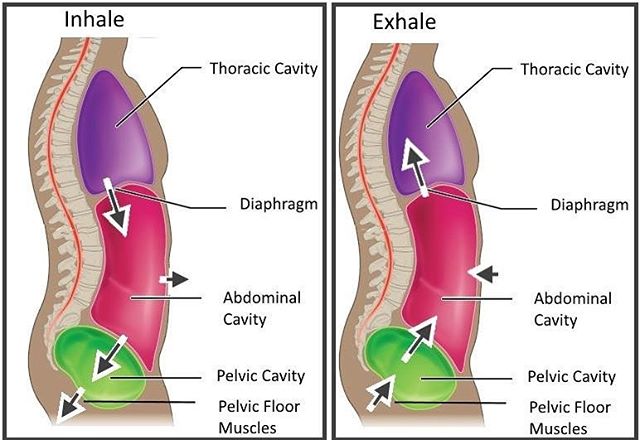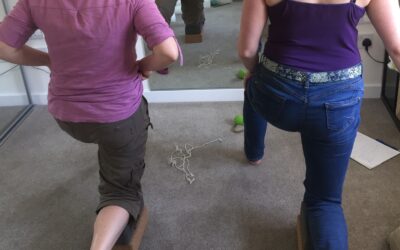In the last few month I’ve encountered at least three exercise classes where the cues have got me rattled. As a recovered sufferer from much core & pelvic floor dysfunction (no, not a fun time!) I am utterly passionate about good core & floor education … and sadly a small part of those classes I attended were a little off.
It was breathing cues that got me rattled and since breathing is so fundamental for our core & floor I want to help sort them out for you … If you’ve been following me for a while you’ll know I’m a ‘why?’ kinda girl and this particular topic has lots of ‘whys?’ so prepare for some evidence and science! Here we go…
First let’s look at how we breathe

Click the image to see breathing in motion!
When we inhale our ribs expand to create space in our lungs which (by virtue of the pressure system) pulls air in. At the same time our diaphragm (a dome shaped muscle which sits at the bottom of our rib cage) contracts & flattens create more space and draw more air in.
As we the exhale the ribs relax and the diaphragm relaxes upwards so the space in the lungs gets smaller and the air is pushed out.
Got it? Then of course we repeat.. and repeat! With me so far? Good..
If you’re not, or want a bit more explanation then have a look at this lesson on breathing from Katy.
So how does our breath connect to our pelvic floor?
Well as we inhale our diaphragm pushes down in the abdominal cavity (tummy!) which expands outwards a little (by relaxing the abdominal muscles) as well as pushing down on the pelvic cavity (bladder, uterus, prostate etc).
Given there’s no extra space hiding in our bodies, what do you think happens when the pelvic cavity is pushed on from above? Yes that right, the base of the pelvic cavity is also pushed down. This base is made up of the pelvic floor muscles.
If the body is functioning well this isn’t a problem; our abdominal & pelvic floor muscles are designed to work in sync with our diaphragm. They relax down as the diaphragm contracts downward and contract (ever so slightly) upward as the diaphragm relaxes upwards.
So inhale, pelvic floor goes down… exhale the pelvic floor goes up. Great.
For you visual folks (or general body nerds like me!) this clip shows an ultrasound of the diaphragm and pelvic floor moving together, it’s pretty awesome!
But why does this matter so much for our pelvic floor & core?
Well if our body is working well then it doesn’t matter. But if anything working less than optimally, has got stuck or out of sync then we may have a problem.
The cues I’ve heard lately have been to ‘draw your pelvic floor up as you inhale’ (which those observant folk amongst you will note is the oppostie to the optimal way I described above) and whilst this might not matter too much on the inhale, exhaling with this breathing pattern could cause us some trouble.
You see if the pelvic floor is contracting up on the inhale then it has to either stay put or move downwards on the exhale. Now on a normal exhale that might not cause any immediate problems because our bodies are adaptable and pretty resilient. However an exhale with a sneeze or cough generates an awful lot more force. The force from this exhale passes through the diaphragm, the abdominal and pelvic cavities and onto the muscles of the pelvic floor and core. Now if these muscles are working sub optimally (as they are when following the ‘draw up on the inhale’ cues’) they are, as every sub-optimally working muscle, much less strong than they could be and, espcially if there are other weaknesses in the body from injury or childbirth, the force of the exhale could be too great for the muscles to withstand meaning we run the risk of something failing;
- Pelvic floor muscles could be forced open causing leaking (known as stress incontinence)
- Abdominal muscles could be pushed apart worsening any diastasis recti
- Pelvic organs could be pushed downwards which may lead to or worsen a prolapse
Even on a normal exhale, if this breathing pattern is repeated regularly, then
- Pelvic floor muscles will be repeatedly over worked
- Pelvic organs including bladder, prostate, uterus will experience regular pressure for which they were not designed
So this all means…
When you breathe in your pelvic floor muscles should be relaxing down. When you breathe out your pelvic floor muscles should be contracting upwards (gently).
If you hear ‘ Inhale, draw the pelvic floor up..’ as I have .. DON’T!! You will be training your body to work in the opposite way to which it was designed and could leave yourself open to pelvic floor dysfunction, pelvic organ prolapse, a poorly functioning prostate or a worsening diastasis recti.
An aside ….
… I don’t teach conscious contraction of the pelvic floor muscles ie I never cue contract your pelvic floor because
– In a well functioning body pelvic floor muscles are under a constant load and respond reflexively to breathe therefore there is no need to train them. My goal is to help you get your body to a place where it starts working reflexively / automatically again so I train movements not specific muscle contractions.
– In a not-so-well functioning body pelvic floor muscles can, as every other muscle, need some training. However when you train (anything) correct form is important and therefore you should train with someone who can evaluate the form of your muscles … and this person is a womens health physio, not me, not a pilates teacher or a yoga teacher or any other fitness professional. You need feedback from a professional who has the training and tools to give it to you!
So what next?
1. Practice breathing where you visualise the diaphragm and pelvic floor working in sync and moving in the same direction
2. Consider seeing a women’s health physio if you have any concerns about your pelvic floor muscles so you can be evaluated
Attributions
Image By OpenStax [CC BY 3.0 (https://creativecommons.org/licenses/by/3.0)], via Wikimedia Commons






